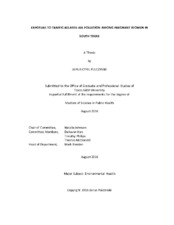Exposure to Traffic-Related Air Pollution among Pregnant Women in South Texas
Abstract
Traffic-related air pollution (TRAP) contributes significantly to overall ambient air pollution, and exposure to TRAP has been implicated in the development of an array of disease states, including asthma, chronic obstructive pulmonary disease (COPD), and lung cancer. TRAP exposure in utero and in early childhood can induce heritable epigenetic alterations. Additionally, in utero and early life TRAP exposure is linked to cognitive impairment, reduced lung function, asthma susceptibility, small for gestational age, and preterm birth. Furthermore, the risk of negative health outcomes increases with small incremental increases in particulate matter (PM) concentrations. Currently, many epidemiologic studies examining air pollution exposure in general or during pregnancy use sophisticated modeling to map exposure, or active air monitors for brief (24 to 48 hours) exposure assessments and use these findings to extrapolate study populations exposure across a lifetime or the course of pregnancy. Furthermore, the EPA utilizes stationary monitors, with limited coverage, to measure air quality and identify regions that fail to meet Air Quality Index (AQI) Standards. This study was conducted to assess the effect of microenvironment on TRAP exposure among pregnant women, a susceptible population, in a region with high childhood asthma incidence, Hidalgo County, Texas. Women were equipped with active air monitors and GPS devices for three separate 24-hour time points to examine the role the microenvironment has on PM exposure as well as examine variation between participants and between sampling points. Participants’ exposure was found to be highly variable and average PM2.5 ranged from almost nonexistent, at 1.92µg/m^3, to unhealthy, at 126.7µg/m^3. Over 82% of participants experienced exposure outside of the “Good” range set by the EPA, and almost a quarter of participants experienced PM2.5 exposure considered “Unhealthy” by the EPA. These results are intriguing given that these participants reside in a region that regularly falls into the “Good” AQI category. Moreover, for this population, the home microenvironment was the dominant microenvironment experienced and the largest single contributor to overall PM2.5 exposure. This study speaks to the inherent variability associated with measuring PM in a population and the need for refined measures of exposure that capture microenvironment variation.
Citation
Pulczinski, Jairus Cyril (2016). Exposure to Traffic-Related Air Pollution among Pregnant Women in South Texas. Master's thesis, Texas A & M University. Available electronically from https : / /hdl .handle .net /1969 .1 /157807.


